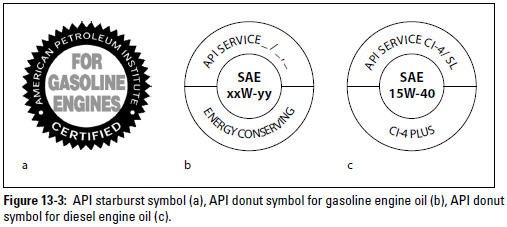Various types of motor oil are on the market, each designed for a particular purpose. This article will help you choose the proper type of oil for your vehicle by explaining the significance of the oil additives, viscosity ratings, and classificationcodes that you'll encounter at auto parts stores and service stations.
Oil Additives
To help the oil keep your engine cool, calm, collected — and clean and corrosion-free — refiners blend in various additives, which can account for as much as 25 percent of the cost of the oil. (Don't confuse these with the aftermarket additives sold at auto supply stores, described in the sidebarcalled "Using aftermarket additives: Should you or shouldn't you?")
The additives in oil help in the following ways:
- They enable the oil to pour better in cold weather.
- They prevent corrosion of the metal parts of the engine.
- They cut down on friction between moving parts.
- They dissolve impurities and prevent sludge from building up.
- They prevent foaming at high temperatures.
Viscosity Ratings
Oil is rated and identified by its viscosity, which determines its ability to flow. In cold weather, oil thickens and becomes less able to flow through the engine. In hot weather, oil thins out, and although it flows well enough, it may become so thin that it can't prevent friction.
|
Using aftermarket additives: Should you or shouldn't you? You can buy three basic types of aftermarket additives in auto parts stores, each of which is designed to augment the additives in the oil itself. The first type thickens the oil. The second type loosens junk and dissolves gummy deposits. The third type acts as a friction lubricant to make the oil "tougher" under extreme temperatures and usage. Remember that even though most oils don't advertise the presence of additives, they already have most of this stuff in them, and no amount of additional additives can improve the performance of oil unless the oil you start with is of the best grade. If you buy a well-known brand, you get all the protection you need in these categories if your engine is in reasonably good shape. If you use API-rated oil of the proper weight and classification and change it often, you can leave the rest of the additives on the store shelves. They may provide temporary relief if the engine is disintegrating, but they're not a cure for a worn-down, filthy, miserable old engine. And using aftermarket oil additives actually may void manufacturer's warranty on some engines. |
Two types of oil are on the market: single-viscosity oil and multi-viscosity oil. (These are also called single-weight and multi-weight or multigrade.) For many years almost every vehicle has been designed to run on multi-viscosity oil. Automakers rate oil viscosity according to the temperature range expected over the oil change period. The lower the number, the thinner the oil and the more easily it flows. In 10W-40 oil, for example, the two numbers mean that it's a multi-viscosity oil that's effective over a range of temperatures. The first number, 10, is an index that refers to how the oil flows at low temperatures. The second number, 40, refers to how it flows at high temperatures. The W designation means that the oil can be used in winter.
To find out which viscosity to choose for your vehicle, look in your owner's manual for an oil viscosity chart. Just select the range of temperatures in any location where you plan to spend a good deal of time driving and the type of driving conditions you will operate under, and look on the chart for the grade of oil recommended for use. If you don't have an owner's manual, check with your dealership.
Oil Classification Codes
The oil industry's American Petroleum Institute (API) has adopted a symbol to certify that a particular motor oil meets the latest industry requirements and codes for protection against deposits, wear, oxidation, and corrosion. The starburst symbol on an oil container label shown in Figure 13-3 means that the oil meets the current engine protection standard and fuel economy requirements of the International Lubricant Standardization and Approval Committee (ILSAC), a joint effort of U.S. and Japanese automobile manufacturers. The API donut symbols also shown in Figure 13-3 mean that the oil meets Energy Conserving requirements (it improves fuel economy by reducing engine friction). Oils without these symbols may not perform as well.
The classification codes for vehicles with gasoline engines started with SA in the early 1960s. As engines became more demanding and oil improved, the codes progressed alphabetically from SB onward. Any oil coded before SJ is no longer considered current. You can use SM (and any future grades that come along) in a vehicle of any age to make the engine run and feel better. All the major brands of oil with the API symbol are equally good.
At publication, CI-4 Plus oil is the latest, most advanced oil for diesel engines. Oils with CF (or higher) designations also are currently acceptable.
 |
Synthetic Oil
A lot of claims have been made about synthetic oils: that they allow longer intervals between oil changes, result in less wear on engine parts, and are able to operate at higher engine temperatures. The longer interval claim has yet to be proven; in fact, one synthetic oil manufacturer that claimed a 20,000-mile oil change interval for its oil has retracted that claim and now suggests that its oil be changed at the normal frequency for mineral-based oils.
A Consumer Reports test found no difference in engine wear between vehicles that had mineral oils in their engines and those that had synthetic oils in their engines. There's no doubt, however, that synthetic oils do perform better than mineral oils at very low and very high temperatures. So if you live in a very cold or hot climate, or if your engine works very hard pulling a trailer or climbing steep hills, synthetic oil may be right for you. Just be forewarned that synthetic oil is expensive; it can cost three times as much as mineral-based oil.
A compromise between synthetic and mineral oil has been developed. This blend of mineral and synthetic oil sells for less than synthetic oil and more than mineral oil.
From Auto Repair for Dummies, copyright © 2009 by Wiley Publishing, Inc., Indianapolis, Indiana. Used by arrangement with John Wiley & Sons, Inc.










